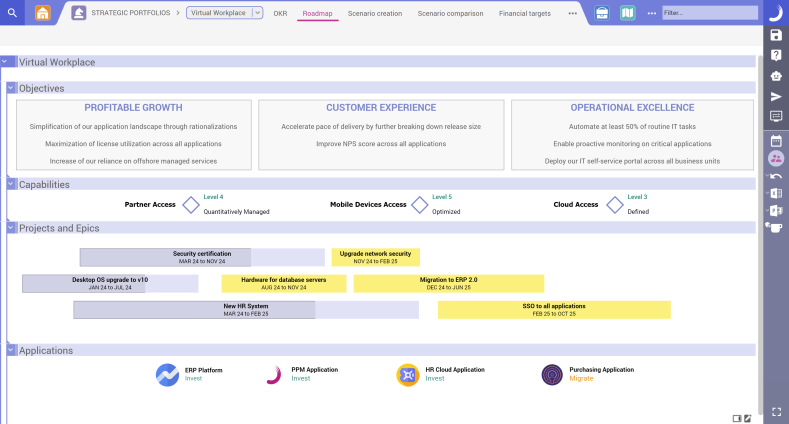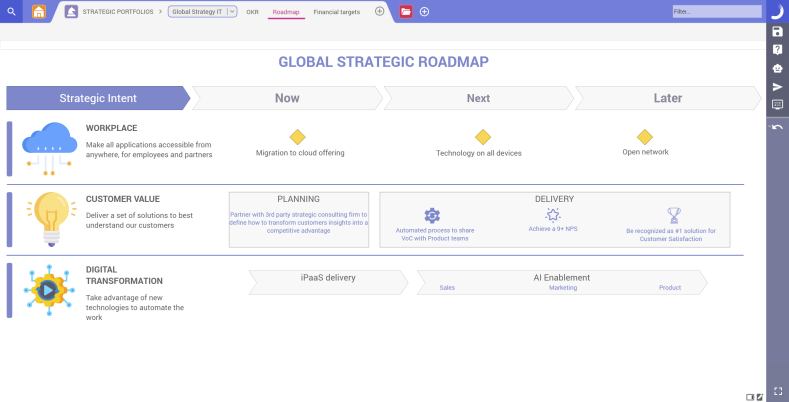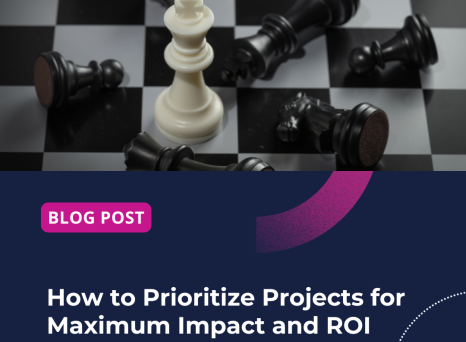61% of C-suite executives admit their business struggles to bridge the gap between strategy formulation and day-to-day implementation.
If this sounds familiar, it might be time to revisit your strategic planning process. Is yours closely tied to execution? Is it actively driving forward your organization’s vision?
What is the strategic planning process?
The strategic planning process is a structured approach to defining an organization’s long-term vision and charting the path to achieving it. It involves clarifying your mission, setting goals, prioritizing and resourcing initiatives, and continually tracking progress.
By creating a clear picture of where you want to go and how success will be measured, strategic planning connects vision to everyday execution. It typically starts with an assessment of your current capabilities and the external environment to uncover strengths, weaknesses, opportunities, and risks.
A successful process will establish a number of measurable performance indicators for evaluating progress and adapting as conditions change. Strategic planning is not a one-time event, but a continuous cycle of execution, measurement, and refinement.
While the process is top-down and shaped by executives, success depends upon organization-wide alignment and execution.
Benefits of a strategic planning process
Having an effective strategic planning process in place ensures a laser-like focus on the initiatives that contribute most to long-term success. It guides innovation and transformation, offering benefits for decision-making, resource management, and cross-team alignment.
- Strategy-execution connection: As a top-down approach, strategic planning makes it more likely that high-value initiatives are funded and resourced. A common pitfall of bottom-up planning is low-impact projects getting the green light.
- Innovation: Strategic planning gives a framework for surfacing, evaluating, and prioritizing new ideas and opportunities based on their strategic value, without losing sight of budgetary and resource constraints.
- Risk management and resilience: Strategic planning encourages you to analyze your own weaknesses and be aware of external market forces, such as macroeconomic shifts, supply chain disruptions, and evolving customer expectations.
- Performance tracking and accountability: By defining clear and measurable goals, strategic planning makes it easier for leaders to monitor progress, hold teams accountable, and celebrate successes.
- Continuous improvement: A well-run planning process encourages regular reviews of your investments, operations, and technologies. This engenders a cultural mindset of ongoing improvement.
- Sense of purpose: By defining your organization’s vision and giving team members clarity about their role in achieving it, a strategic plan provides direction and focus. This creates cross-team alignment.
The strategic planning process: 6 key steps for success
Every strategic planning journey is unique, but many successful cycles follow six core steps: securing buy-in, defining your mission, assessing current market position, setting strategic goals, prioritizing and mapping work, and ongoing performance evaluation.
1. Secure internal buy-in
Without commitment from the entire organization, a strategic planning process is a non-starter. From the C-suite to individual contributors, everyone should feel invested.
A key first step is building an awareness of the importance of having a strategic planning process; and if no process exists, you’ll need to articulate the risk of continuing without one. If you do have a process in place, you’ll need to construct a case for why it needs to be reimagined and strengthened.
Establishing this level of organization-wide understanding might entail seminars, training programs, workshops, lunch-and-learns, or Q&A sessions.
Encourage everyone to share insights, concerns, and ambitions. This input not only gives a sense of inclusion and ownership over the process, but can inform the following planning stages.
You should aim to maintain this buy-in at every stage. This will be easier once the strategic plan starts to bear fruit, as celebrating and championing success stories naturally builds momentum.
2. Define your mission and vision
This is the foundation of the entire strategic planning process. These core ideas should paint a clear picture of your organization and how you define success.
To ensure you’re getting to the heart of expressing your mission (that is, why you exist), some key questions to ask include:
- Why does our organization exist beyond making money?
- Who do we serve and what unique value do we provide?
- What problems are we here to solve?
- If we didn’t exist, what would be missing?
- How would our customers describe our purpose?
When it comes to vision (where you’re going), consider:
- What sort of future do we want for our customers, stakeholders, and community?
- If we become hugely successful in the next 10 years, what will be true about us?
- How will the world be different because of what we do?
- What does “winning” look like for us long-term?
- What should people (our customers, employees, partners) say about us in the future?
Once you’ve got answers, they can be distilled into short, powerful statements. These should be clear and memorable—the easier they are to recall and repeat, the better.
Some well-regarded examples of the mission and vision statements include:
- “To organize the world’s information and make it universally accessible and useful.” (Google)
- “To bring inspiration and innovation to every athlete in the world.” (Nike)
- “To accelerate the world’s transition to sustainable energy.” (Tesla)
- “To empower every person and every organization on the planet to achieve more.” (Microsoft)
- “To be Earth’s most customer-centric company, Earth’s best employer, and Earth’s safest place to work.” (Amazon)
- “We dedicate ourselves to humanity’s quest for longer, healthier, happier lives through innovation in biopharmaceuticals.” (Pfizer)
- “To make humanity multiplanetary.” (SpaceX)
- “To connect the world’s professionals to make them more productive and successful.” (LinkedIn)
- “We’re in business to save our home planet.” (Patagonia)
3. Assess your current market position
Now that you know where you want to be, it’s time to take stock of where you currently are. Consult as widely as possible with all stakeholders, including customers and suppliers.
What are your strengths and where do you have a USP compared to competitors? Are there any further opportunities to develop this advantage?
Think about internal issues and weaknesses, too. Be brutally honest. What would your competitors say about your business’s vulnerabilities? Where do you have a skills deficit?
Then, turn to external factors. Think in relation to your customers, suppliers, and competitors. What threats and opportunities exist in the market? You might be impacted by technological, political, or cultural trends and changes.
The SWOT analysis is a time-honored framework for getting a clear picture of what you do well, where you’re vulnerable, and the opportunities and external threats that exist.
4. Identify strategic priorities and set goals
This is when you start to build your strategic direction into something tangible, using your mission and vision statements as a lens for identifying top strategic priorities.
Generic examples of strategic priorities across several industries might include:
- Healthcare: Accelerate drug development timelines, improve patient outcomes, expand access to care
- CPG: Accelerate product innovation cycles, enhance demand forecasting accuracy, deepen brand loyalty
- Project controls: Standardize project governance, improve cost predictability, increase portfolio visibility with analytics
- Energy: Transition to renewables, modernize grid infrastructure, improve operational safety
- Aerospace: Strengthen supply chain resilience, adopt digital engineering, enhance program delivery
These can be categorized as critical, important, desirable, and most importantly, obtainable in the short, medium, and long term.
Now, focus should turn to establishing metrics and goals that reflect these priorities.
Objectives and key results (OKRs) are a fantastic framework for linking your strategic priorities to measurable outcomes. The objective is your strategic priority, while the key results are specific outcomes—usually 3–5 support metrics—that demonstrate progress towards that goal. These metrics should be SMART (Specific, Measurable, Achievable, Relevant, and Time-bound).
A very top-level example for a tech organization might look like this:
- Objective: Accelerate cloud adoption across the organization
- Key results:
- Move 3 major business-critical systems to the cloud by year-end
- Achieve 50% reduction in legacy server footprint
- Achieve 100% compliance with new cloud security and governance standards by Q4
5. Create an action plan and prioritize initiatives
This is the point when you move from the abstract to the concrete and make your vision reality. Which projects will help you move closer to achieving the strategic priorities you identified earlier?
List potential initiatives that could advance these priorities. Structured brainstorming can be a good place to start. There are no bad ideas—after all, there are countless different ways to deliver business value. Group ideas that are similar, estimate the effort and impact, and detail dependencies or risks.
To ensure funding and resources are allocated to the most strategically-relevant initiatives, use a prioritization framework. Common prioritization techniques include weighted scoring models (ranking initiatives by strategic fit, expected ROI, risk level, and resource requirements), the MoSCoW method (must-have, should-have, could-have, won’t-have), and RICE (reach, impact, confidence, effort).
Modern strategic portfolio management (SPM) solutions also offer “what-if” scenario planning tools that make it simple to model different project combinations and resource allocations. This can reveal the trade-offs of pursuing or pausing initiatives.
Clearly define owners, milestones, and resource needs for each initiative and assign accountability from leadership through to individual contributors. Keep it simple and centered on high-impact work that advances your core mission.
Once you know exactly what projects and initiatives you want to execute to support your strategic objectives, you can visualize them by building out a roadmap.
Strategic roadmaps: linking strategic thinking to execution
The integrated strategic roadmap tracks all goals, initiatives, and timelines in one place. It ties execution to strategy, ensuring your portfolios, programs, products, and projects are coordinated and deliver on your overarching mission and vision.
A roadmap should be responsive and dynamic, adapting as priorities or external conditions change. It holds great power as a practical blueprint and visual tool for communicating progress to key stakeholders.

Strategic IT roadmap linking objectives to key projects with timelines

Five-year strategy roadmap showing cloud, digital, and innovation priorities with milestones
6. Review and refresh
As you’ll likely already have gathered, strategic planning isn’t a set-and-forget activity. To stay on track to reach your goal, you need constant course corrections.
Continually update and reevaluate your strategic plan at regular intervals, perhaps quarterly, keeping a close watch on timelines and performance targets so you can pivot and reallocate funding and resourcing when needed. A good strategic planning tool will help with this, alerting you of potential bottlenecks, inefficiency, and misalignment.
Don’t forget the external, either. Stay abreast of changes in consumer behaviour, economic shifts, and regulatory changes.
The entire process of revisiting your mission and vision (that is, going back to step 1) may take place every three to five years, or whenever there’s a significant market shift.
Top tip: Make strategy a habit, rather than an annual event. Build regular strategic thinking into your calendar. For example, schedule one hour per day for executives, one hour per week for managers, one hour per month for individuals.
There’s also the 5% rule, which is championed by Bill Dow. Here, the idea is that every team member dedicates just 5% of their time on process improvement. That’s about two hours a week in a typical 40-hour work week.
Supercharge your strategic planning process with Planisware
Strategic planning should be seen as an incremental and iterative process that moves you slowly towards where you want to be. Having the right tools in your arsenal will maximize your chances of long-term success.
Recognized as an SPM leader and with a 98% client satisfaction rate, Planisware powers the strategic planning of some of the world’s largest enterprises. Boasting world-class roadmapping capabilities leveraging the latest advances in AI, our SPM solutions help you create a clear view of your objectives and align your investments with strategic themes.
Book a one-to-one demo to discover how Planisware can help you to turn strategy into real-world impact.


